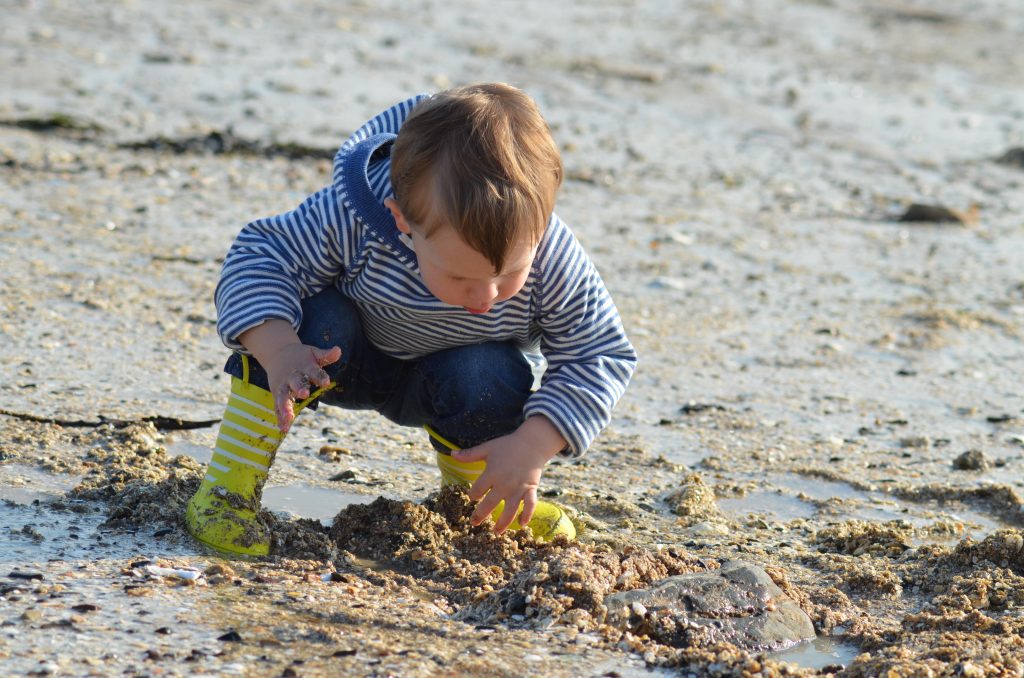Chapter 1: The centrality of play in early childhood
Back to overview of chapter resources Chapter authors Nancy Stewart Kierna Corr Julia Henderson Chapter overview Play is a fundamental in childhood, and enshrined as
Taking a Scottish perspective, this chapter shows how, building on the early roots of outdoor learning, recent policy has promoted outdoor learning in the early years. In this chapter, Elizabeth Henderson shares her account of establishing a Community of Practice (CoP) to support practitioners in providing outdoor experiences for young children. Case studies from CoP practitioners, focus on: going to a local green space with children; den building as a provocation; and a child under 2 learning through her senses. The chapter highlights the role of a CoP in nurturing belonging and agency in times of change.
When thinking about going outside with young children there is a lot to consider. The practicalities, as well as the onerous administration, can be daunting. Here you can find the documents developed by Maggie and Jacqueline after Maggie attended a Wee Green Spaces training with Juliet Robertson
These proformas might just help you to get outside with more confidence. It is important to remember, however, that Kania et al. (see Chapter 5) identified three levels and six conditions for sustainable change and these include relationships with staff, parents and senior management as well as the need to change attitudes and beliefs.
When people feel afraid or threatened, they are less likely to want to change. If you can, therefore, make sure all documentation is sound you can help to nurture a sense of safety and confidence in staff, parents, and senior management.
Maggie and Jacqueline hosted parent meetings to discuss their proposals and included parents as helpers on their journey. Parent to parent peer-mentoring helps build confidence all round and can nurture sustainable changes within your early years setting.
In this section Helen shares her den building research Powerpoint – available with audio so you can hear her share her story.
Helen shares a video, that captures the development of her outdoor play space into a movement rich space with loose parts. This film uses ideas based around Jan White’s book Every child a mover published by Early Education
In this section Emma shares three case studies from her research: The Courage to Learn: what risks do children under two years-old take to learn about the world and themselves in an outdoor context?
Casey, D., Richardson, A., and d’Ascoli, H. (2029). The Children’s Forest. Hawthorn Press
Hanscom, A. (2016). Balanced and Barefoot. New Harbinger Publications
Robertson, J. (2014). Dirty Teaching. Crown House Publishing
Boulton, P. and Thomas, A. (2022) How does play in the outdoors afford opportunities for schema development in young children? International Journal of Play, 11:2, 184-201, DOI: 10.1080/21594937.2022.2069348
Prince, H.E. (2019). The sustained value teachers place on outdoor learning, Education 3-13, DOI: 10.1080/03004279.2019.1633376
Canning, N. (2013). ‘Where’s the bear? Over there!’ – creative thinking and imagination in den making, Early Child Development and Care, 183:8, 1042-1053, DOI: 10.1080/03004430.2013.772989
Canning, N. (2010). The influence of the outdoor environment: den‐making in three different contexts, European Early Childhood Education Research Journal, 18:4, 555-566, DOI: 10.1080/1350293X.2010.525961
Murray, E.J. & Hrusa Williams, P. (2019). Risk-tasking and Assessment in Toddlers During Nature Play: The Role of Family and Play Context, Journal of Adventure Education and Outdoor Learning, DOI: 10.1080/14729679.2019.1660193
WWF-UK and the Mental Health Foundation (2020) Thriving with Nature Guidebook
Wenger, E. (1998). Communities of Practice: learning, meaning, and identity. Cambridge University Press.
Curtis, D., Leo, D., Cividanes, W.C.M. & Carter, M. (2013). Reflecting in Communities of Practice: a workbook for early childhood educators. Redleaf Press.
Here are 12 links to video clips on outdoor nurseries, outdoor practices and policies.

Back to overview of chapter resources Chapter authors Nancy Stewart Kierna Corr Julia Henderson Chapter overview Play is a fundamental in childhood, and enshrined as
Back to overview of chapter resources Chapter authors Verity Campbell- Barr Sasha Tregenza May Chapter overview In this chapter, we explore and analyse developments in
Back to overview of chapter resources Chapter authors Sue Allingham Nicola Brinning Chapter overview This chapter is built around the policy contexts of Wales and
Back to overview of chapter resources Chapter authors Alison Featherbe Louise Lloyd-Evans Helen Moylett Chapter overview In the early years, where our habits of mind
Back to overview of chapter resources Chapter authors Cathy Nutbrown Becky Cook Chapter overview Early childhood education settings are increasingly, developing work with parents to
Back to overview of chapter resources Chapter authors Aline-Wendy Dunlop Lisa Barnes Myra McRobbie Chapter overview In this chapter we have chosen a transitions lens
Back to overview of chapter resources Chapter authors Jan Georgeson Emma Short Helen Adams Kate Ullman Chapter overview This chapter traces a brief history of
Back to overview of chapter resources Chapter authors Stella Louis Sally Cave Nasma Meah Chapter overview This chapter outlines what anti-discriminatory practice is and the
Back to overview of chapter resources Chapter authors Shaddai Tembo Fifi Benham Chapter overview This chapter examines the role of gender and LGBTQ+ inclusive practice
Back to overview of chapter resources Chapter authors Kathy Sylva Lesley Curtis Chapter overview This chapter explores the role of Children’s Centres (CCs) in serving
Back to overview of chapter resources Chapter authors Nathan Archer David Yates Chapter overview When considering the future, looking back at recent changes in the
Back to overview of chapter resources Chapter authors Elizabeth Wood Louise Kay Jessica Travers Chapter overview This chapter draws on international research to indicate how
Back to overview of chapter resources Chapter authors Cathy Nutbrown Beatrice Merrick Chapter overview This chapter is a little different from the others. It considers






Early Education
2 Victoria Square
St Albans
AL1 3TF
T: 01727 884925
E: office@early-education.org.uk